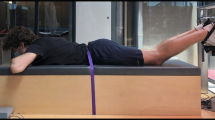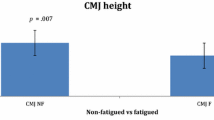Abstract
To examine the kinematic characteristics of the hip and knee during a single-leg stop-jump task before and after exercise-to-fatigue, and to determine if the fatigue response is gender-dependent. Lower extremity kinematic measurements were taken of male and female subjects while they performed a sports functional task before and after fatigue developed from exhaustive running. Thirty healthy, physically active subjects (15 males and 15 females) Knee and hip joint kinematics were calculated utilizing three-dimensional video analysis. Each subject performed five single-leg stop-jumps before and after an exercise-to-fatigue bout. All subjects underwent a fatigue protocol using the modified Astrand protocol. Fatigue was verified using the Rating of Perceived Exertion along with the subject’s heart rate. All data were analyzed using two factor (test × gender) repeated measures ANOVA (P < 0.05). Both males and females demonstrated significantly less maximal knee valgus (P = 0.038) and decreased knee flexion at initial contact (P = 0.009) post-fatigue. No significant differences were identified in hip joint angles between sessions or between sexes. The results show that fatigue developed from exhaustive running alters lower extremity kinematics during a single-leg stop-jump task. The more neutral position in the frontal plane might be an effort to protect the knee. The decrease in knee flexion at initial contact may be an attempt to increase knee stability following fatigue. Our results did not reveal any gender differences in this specific task.
Similar content being viewed by others
References
Boden BP, Dean GS, Feagin JA Jr, Garrett WE Jr (2000) Mechanisms of anterior cruciate ligament injury. Orthopedics 23:573–578
Noyes FR, Matthews DS, Mooar PA, Grood ES (1983) The symptomatic anterior cruciate-deficient knee. Part II: the results of rehabilitation, activity modification, and counseling on functional disability. J Bone Joint Surg Am 65:163–174
Harmon KG, Ireland ML (2000) Gender differences in noncontact anterior cruciate ligament injuries. Clin Sports Med 19:287–302
Griffin LY, Albohm MJ, Arendt EA et al (2006) Understanding and preventing noncontact anterior cruciate ligament injuries: a review of the Hunt Valley II meeting, January 2005. Am J Sports Med 34:1512–1532
Chappell JD, Herman DC, Knight BS, Kirkendall DT, Garrett Jr WE, Yu B (2005) Effect of fatigue on knee kinetics and kinematics in stop-jump tasks. Am J Sports Med 33:1022–1029
Rodacki AL, Fowler NE, Bennett SJ (2001) Multi-segment coordination: fatigue effects. Med Sci Sports Exerc 33:1157–1167
Feagin JA Jr, Lambert KL, Cunningham RR et al (1987) Consideration of the anterior cruciate ligament injury in skiing. Clin Orthop Rel Res 216:13–18
Gabbett TJ (2000) Incidence, site, and nature of injuries in amateur rugby league over three consecutive seasons. Br J Sports Med 34:98–103
Gabbett TJ (2004) Incidence of injury in junior and senior rugby league players. Sports Med 34:849–859
Molsa J, Airaksinen O, Nasman O, Torstila I (1997) Ice hockey injuries in Finland. A prospective epidemiologic study. Am J Sports Med 25:495–499
Pettrone FA, Ricciardelli E (1987) Gymnastic injuries: the Virginia experience 1982–1983. Am J Sports Med 15:59–62
Stuart MJ, Smith A (1995) Injuries in Junior A ice hockey. A three-year prospective study. Am J Sports Med 23:458–461
Johnston RB 3rd, Howard ME, Cawley PW, Losse GM (1998) Effect of lower extremity muscular fatigue on motor control performance. Med Sci Sports Exerc 30:1703–1707
Wojtys EM, Wylie BB, Huston LJ (1996) The effects of muscle fatigue on neuromuscular function and anterior tibial translation in healthy knees. Am J Sports Med 24:615–621
Skinner HB, Wyatt MP, Stone ML, Hodgdon JA, Barrack RL (1986) Exercise-related knee joint laxity. Am J Sports Med 14:30–34
Rozzi SL, Lephart SM, Fu FH (1999) Effects of muscular fatigue on knee joint laxity and neuromuscular characteristics of male and female athletes. J Athl Train 34:106–114
Hiemstra LA, Lo IK, Fowler PJ (2001) Effect of fatigue on knee proprioception: implications for dynamic stabilization. J Orthop Sports Phys Ther 31:598–605
Lattanzio PJ, Petrella RJ (1998) Knee proprioception: a review of mechanisms, measurements, and implications of muscular fatigue. Orthopedics 21:463–470
Lattanzio PJ, Petrella RJ, Sproule JR, Fowler PJ (1997) Effects of fatigue on knee proprioception. Clin J Sport Med 7:22–27
Miura K, Ishibashi Y, Tsuda E, Okamura Y, Otsuka H, Toh S (2004) The effect of local and general fatigue on knee proprioception. Arthroscopy 20:414–418
Nyland JA, Shapiro R, Caborn DN, Nitz AJ, Malone TR (1997) The effect of quadriceps femoris, hamstring, and placebo eccentric fatigue on knee and ankle dynamics during crossover cutting. J Orthop Sports Phys Ther 25:171–184
McLean SG, Felin RE, Suedekum N, Calabrese G, Passerallo A, Joy S (2007) Impact of fatigue on gender-based high-risk landing strategies. Med Sci Sports Exerc 39:502–514
Vaughan C, Davis BL, O’Connor JC (1999) Dynamics of Human Gait. 2nd edn. Kiboho, Cape Town
Chao EY (1980) Justification of triaxial goniometer for the measurement of joint rotation. J Biomech 13:989–1006
Grood ES, Suntay WJ (1983) A joint coordinate system for the clinical description of three-dimensional motions: application to the knee. J Biomech Eng 105:136–144
Olsen OE, Myklebust G, Engebretsen L, Bahr R (2004) Injury mechanisms for anterior cruciate ligament injuries in team handball: a systematic video analysis. Am J Sports Med 32:1002–1012
McLean SG, Huang X, van den Bogert AJ (2005) Association between lower extremity posture at contact and peak knee valgus moment during sidestepping: implications for ACL injury. Clin Biomech (Bristol, Avon) 20:863–870
Yu B, Lin CF, Garrett WE (2006) Lower extremity biomechanics during the landing of a stop-jump task. Clin Biomech (Bristol, Avon) 21:297–305
Kang J, Chaloupka EC, Mastrangelo MA, Biren GB, Robertson RJ (2001) Physiological comparisons among three maximal treadmill exercise protocols in trained and untrained individuals. Eur J Appl Physiol 84:291–295
Pollock LM, Wilmore JH, Fox SM (1978) Health and fitness through physical activity. Wiley, New York, p 59
Borg GA (1982) Psychophysical bases of perceived exertion. Med Sci Sports Exerc 14:377–381
Wilmore JH, Costill DL (1994) Physiology of sport and exercise. Human Kinetics, Champaign
Jackson KM (1979) Fitting of mathematical functions to biomechanical data. IEEE Trans Biomed Eng 26:122–124
Toth AP, Cordasco FA (2001) Anterior cruciate ligament injuries in the female athlete. J Gender Spec Med 4:25–34
Arendt EA, Agel J, Dick R (1999) Anterior cruciate ligament injury patterns among collegiate men and women. J Athl Train 34:86–92
Ireland ML (1999) Anterior cruciate ligament injury in female athletes: epidemiology. J Athl Train 34:150–154
Arms SW, Pope MH, Johnson RJ, Fischer RA, Arvidsson I, Eriksson E (1984) The biomechanics of anterior cruciate ligament rehabilitation and reconstruction. Am J Sports Med 12:8–18
Bendjaballah MZ, Shirazi-Adl A, Zukor DJ (1997) Finite element analysis of human knee joint in varus–valgus. Clin Biomech (Bristol, Avon) 12:139–148
Kanamori A, Woo SL, Ma CB et al (2000) The forces in the anterior cruciate ligament and knee kinematics during a simulated pivot shift test: a human cadaveric study using robotic technology. Arthrosc 16:633–639
Markolf KL, Burchfield DM, Shapiro MM, Shepard MF, Finerman GA, Slauterbeck JL (1995) Combined knee loading states that generate high anterior cruciate ligament forces. J Orthop Res 13:930–935
Markolf KL, Mensch JS, Amstutz HC (1976) Stiffness and laxity of the knee—the contributions of the supporting structures. A quantitative in vitro study. J Bone Joint Surg Am 58:583–594
Markolf KL, Gorek JF, Kabo JM, Shapiro MS (1990) Direct measurement of resultant forces in the anterior criciate ligament. An in vitro study performed with a new experimental technique. J Bone Joint Surg Am 72:557–567
Sakane M, Fox RJ, Woo SL, Livesay GA, Li G, Fu FH (1997) In situ forces in the anterior cruciate ligament and its bundles in response to anterior tibial loads. J Orthop Res 15:285–293
Fleming BC, Renstrom PA, Ohlen G et al (2001) The gastrocnemius muscle is and antagonist of the anterior cruciate ligament. J Orthop Res 19:1178–1184
Lepers R, Hausswirth C, Maffiuletti N, Brisswalter J, van Hoecke J (2000) Evidence of neuromuscular fatigue after prolonged cycling exercise. Med Sci Sports Exerc 32:1880–1886
Dufek JS, Bates BT (1990) The evaluation and prediction of impact forces during landings. Med Sci Sports Exerc 22:370–377
Moore BD, Drouin J, Gansneder BM, Shultz SJ (2002) The differential effects of fatigue on reflex response timing and amplitude in males and females. J Electromyogr Kinesiol 12:351–360
Nyland JA, Shapiro R, Stine RL, Horn TS, Ireland ML (1994) Relationship of fatigued run and rapid stop to ground reaction forces, lower extremity kinematics, and muscle activation. J Orthop Sports Phys Ther 20:132–137
Cerullo JF (2000) The effect of lower extremity muscle fatigue on vertical ground reaction forces and muscle activation patterns during landing. Doctoral dissertation
Acknowledgments
Research was funded by a grant from the National Athletic Trainers’ Association Research and Education Foundation Osternig masters grant program.
Author information
Authors and Affiliations
Corresponding author
Rights and permissions
About this article
Cite this article
Benjaminse, A., Habu, A., Sell, T.C. et al. Fatigue alters lower extremity kinematics during a single-leg stop-jump task. Knee Surg Sports Traumatol Arthr 16, 400–407 (2008). https://doi.org/10.1007/s00167-007-0432-7
Received:
Accepted:
Published:
Issue Date:
DOI: https://doi.org/10.1007/s00167-007-0432-7




